2008 MERCEDES-BENZ E-CLASS ESTATE seats
[x] Cancel search: seatsPage 47 of 401
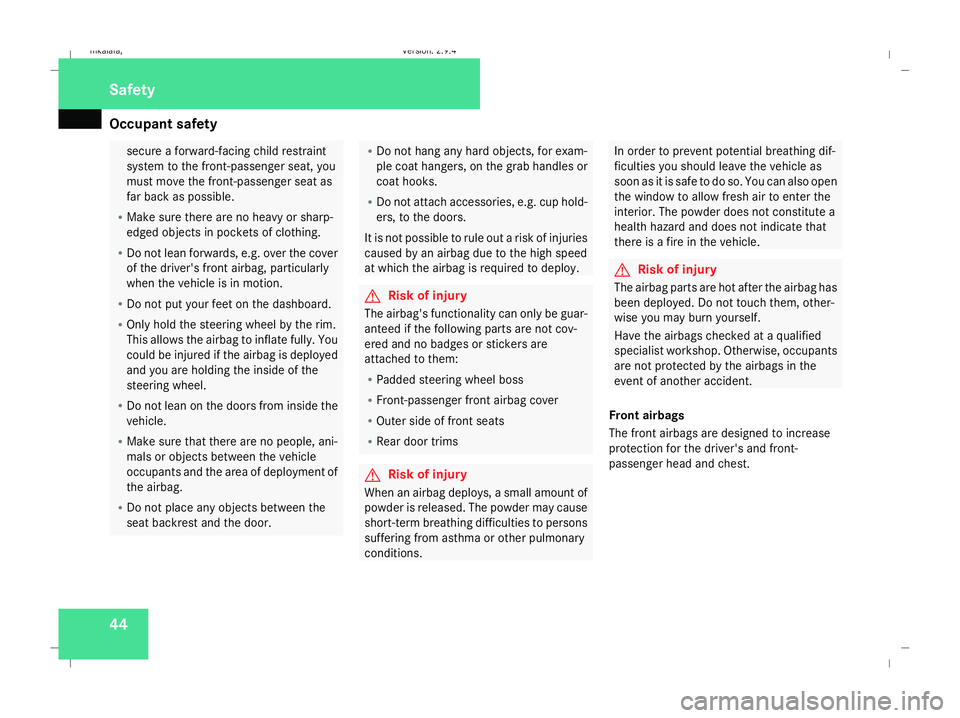
Occupant safety
44 secure a forward-facing child restraint
system to the front-passenger seat, you
must move the front-passenger seat as
far back as possible.
R Make sure there are no heavy or sharp-
edged objects in pockets of clothing.
R Do not lean forwards, e.g. over the cover
of the driver's front airbag, particularly
when the vehicle is in motion.
R Do not put your feet on the dashboard.
R Only hold the steering wheel by the rim.
This allows the airbag to inflate fully. You
could be injured if the airbag is deployed
and you are holding the inside of the
steering wheel.
R Do not lean on the doors from inside the
vehicle.
R Make sure that there are no people, ani-
mals or objects between the vehicle
occupants and the area of deployment of
the airbag.
R Do not place any objects between the
seat backrest and the door. R
Do not hang any hard objects, for exam-
ple coat hangers, on the grab handles or
coat hooks.
R Do not attach accessories, e.g. cup hold-
ers, to the doors.
It is not possible to rule out a risk of injuries
caused by an airbag due to the high speed
at which the airbag is required to deploy. G
Risk of injury
The airbag's functionality can only be guar-
anteed if the following parts are not cov-
ered and no badges or stickers are
attached to them:
R Padded steering wheel boss
R Front-passenger front airbag cover
R Outer side of front seats
R Rear door trims G
Risk of injury
When an airbag deploys, a small amount of
powder is released. The powder may cause
short-term breathing difficulties to persons
suffering from asthma or other pulmonary
conditions. In order to prevent potential breathing dif-
ficulties you should leave the vehicle as
soon as it is safe to do so. You can also open
the window to allow fresh air to enter the
interior. The powder does not constitute a
health hazard and does not indicate that
there is a fire in the vehicle. G
Risk of injury
The airbag parts are hot after the airbag has
been deployed. Do not touch them, other-
wise you may burn yourself.
Have the airbags checked at a qualified
specialist workshop. Otherwise, occupants
are not protected by the airbags in the
event of another accident.
Front airbags
The front airbags are designed to increase
protection for the driver's and front-
passenger head and chest. Safety
211_AKB; 2; 5, en-GB
mkalafa,
Version: 2.9.4 2008-02-29T16:57:07+01:00 - Seite 44Dateiname: 6515_3416_02_buchblock.pdf; preflight
Page 50 of 401
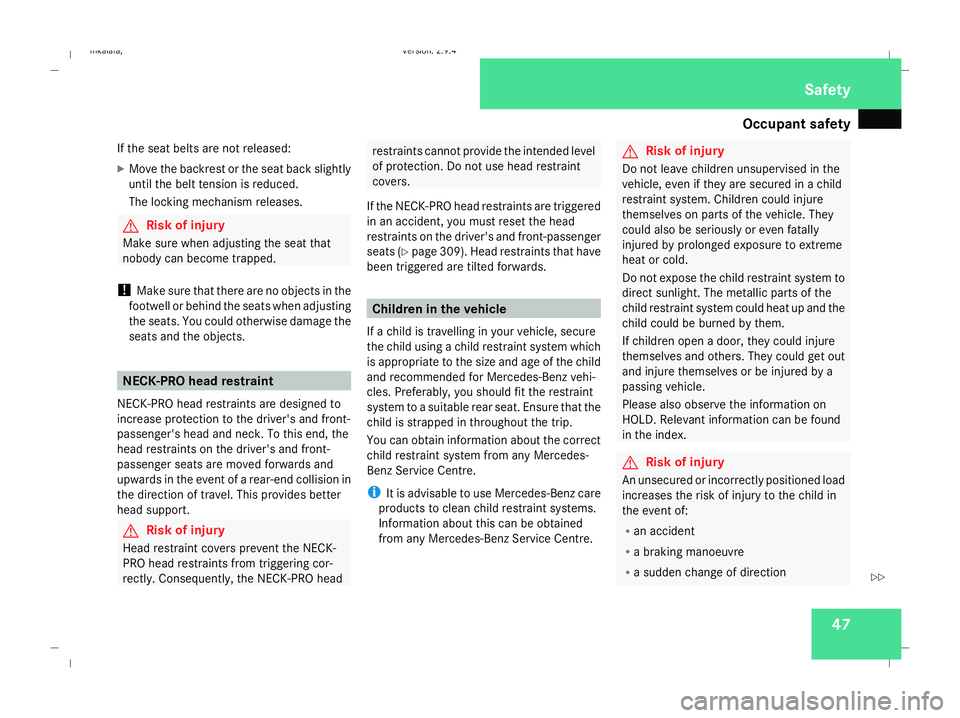
Occupant safety
47
If the seat belts are not released:
X
Move the backrest or the seat back slightly
until the belt tension is reduced.
The locking mechanism releases. G
Risk of injury
Make sure when adjusting the seat that
nobody can become trapped.
! Make sure that there are no objects in the
footwell or behind the seats when adjusting
the seats. You could otherwise damage the
seats and the objects. NECK-PRO head restraint
NECK-PRO head restraints are designed to
increase protection to the driver's and front-
passenger's head and neck. To this end, the
head restraints on the driver's and front-
passenger seats are moved forwards and
upwards in the event of a rear-end collision in
the direction of travel. This provides better
head support. G
Risk of injury
Head restraint covers prevent the NECK-
PRO head restraints from triggering cor-
rectly. Consequently, the NECK-PRO head restraints cannot provide the intended level
of protection. Do not use head restraint
covers.
If the NECK-PRO head restraints are triggered
in an accident, you must reset the head
restraints on the driver's and front-passenger
seats (Y page 309). Head restraints that have
been triggered are tilted forwards. Children in the vehicle
If a child is travelling in your vehicle, secure
the child using a child restraint system which
is appropriate to the size and age of the child
and recommended for Mercedes-Benz vehi-
cles. Preferably, you should fit the restraint
system to a suitable rear seat. Ensure that the
child is strapped in throughout the trip.
You can obtain information about the correct
child restraint system from any Mercedes-
Benz Service Centre.
i It is advisable to use Mercedes-Benz care
products to clean child restraint systems.
Information about this can be obtained
from any Mercedes-Benz Service Centre. G
Risk of injury
Do not leave children unsupervised in the
vehicle, even if they are secured in a child
restraint system. Children could injure
themselves on parts of the vehicle. They
could also be seriously or even fatally
injured by prolonged exposure to extreme
heat or cold.
Do not expose the child restraint system to
direct sunlight. The metallic parts of the
child restraint system could heat up and the
child could be burned by them.
If children open a door, they could injure
themselves and others. They could get out
and injure themselves or be injured by a
passing vehicle.
Please also observe the information on
HOLD. Relevant information can be found
in the index. G
Risk of injury
An unsecured or incorrectly positioned load
increases the risk of injury to the child in
the event of:
R an accident
R a braking manoeuvre
R a sudden change of direction Safety
211_AKB; 2; 5, en-GB
mkalafa,
Version: 2.9.4
2008-02-29T16:57:07+01:00 - Seite 47 ZDateiname: 6515_3416_02_buchblock.pdf; preflight
Page 51 of 401
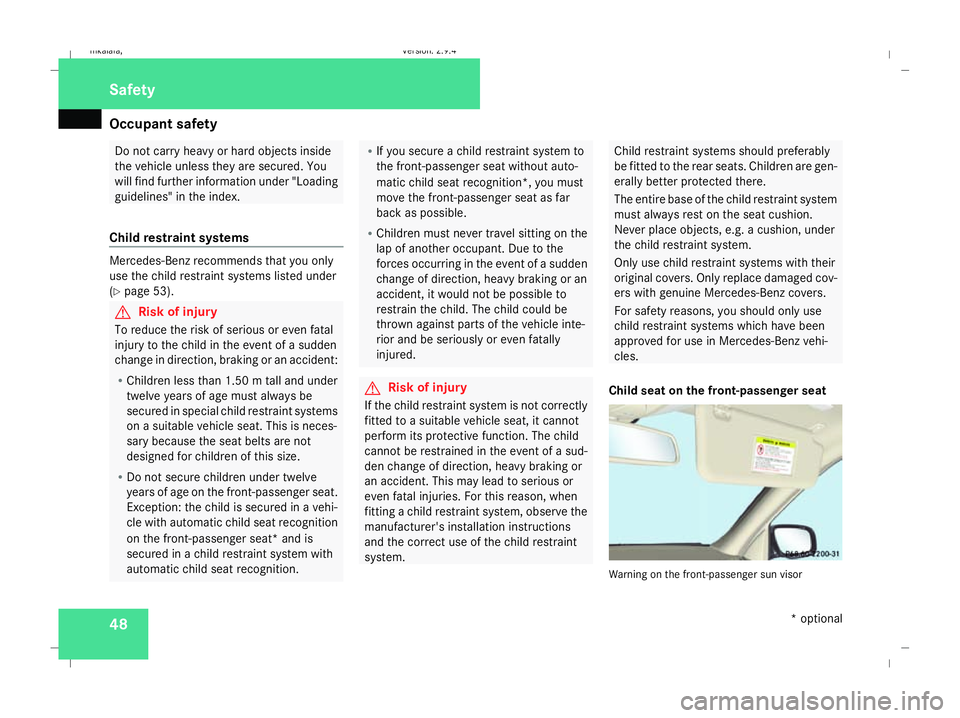
Occupant safety
48 Do not carry heavy or hard objects inside
the vehicle unless they are secured. You
will find further information under "Loading
guidelines" in the index.
Child restraint systems Mercedes-Benz recommends that you only
use the child restraint systems listed under
(Y page 53). G
Risk of injury
To reduce the risk of serious or even fatal
injury to the child in the event of a sudden
change in direction, braking or an accident:
R Children less than 1.50 m tall and under
twelve years of age must always be
secured in special child restraint systems
on a suitable vehicle seat. This is neces-
sary because the seat belts are not
designed for children of this size.
R Do not secure children under twelve
years of age on the front-passenger seat.
Exception: the child is secured in a vehi-
cle with automatic child seat recognition
on the front-passenger seat* and is
secured in a child restraint system with
automatic child seat recognition. R
If you secure a child restraint system to
the front-passenger seat without auto-
matic child seat recognition*, you must
move the front-passenger seat as far
back as possible.
R Children must never travel sitting on the
lap of another occupant. Due to the
forces occurring in the event of a sudden
change of direction, heavy braking or an
accident, it would not be possible to
restrain the child. The child could be
thrown against parts of the vehicle inte-
rior and be seriously or even fatally
injured. G
Risk of injury
If the child restraint system is not correctly
fitted to a suitable vehicle seat, it cannot
perform its protective function. The child
cannot be restrained in the event of a sud-
den change of direction, heavy braking or
an accident. This may lead to serious or
even fatal injuries. For this reason, when
fitting a child restraint system, observe the
manufacturer's installation instructions
and the correct use of the child restraint
system. Child restraint systems should preferably
be fitted to the rear seats. Children are gen-
erally better protected there.
The entire base of the child restraint system
must always rest on the seat cushion.
Never place objects, e.g. a cushion, under
the child restraint system.
Only use child restraint systems with their
original covers. Only replace damaged cov-
ers with genuine Mercedes-Benz covers.
For safety reasons, you should only use
child restraint systems which have been
approved for use in Mercedes-Benz vehi-
cles.
Child seat on the front-passenger seat Warning on the front-passenger sun visorSafety
* optional
211_AKB; 2; 5, en-GB
mkalafa,
Version: 2.9.4 2008-02-29T16:57:07+01:00 - Seite 48Dateiname: 6515_3416_02_buchblock.pdf; preflight
Page 54 of 401
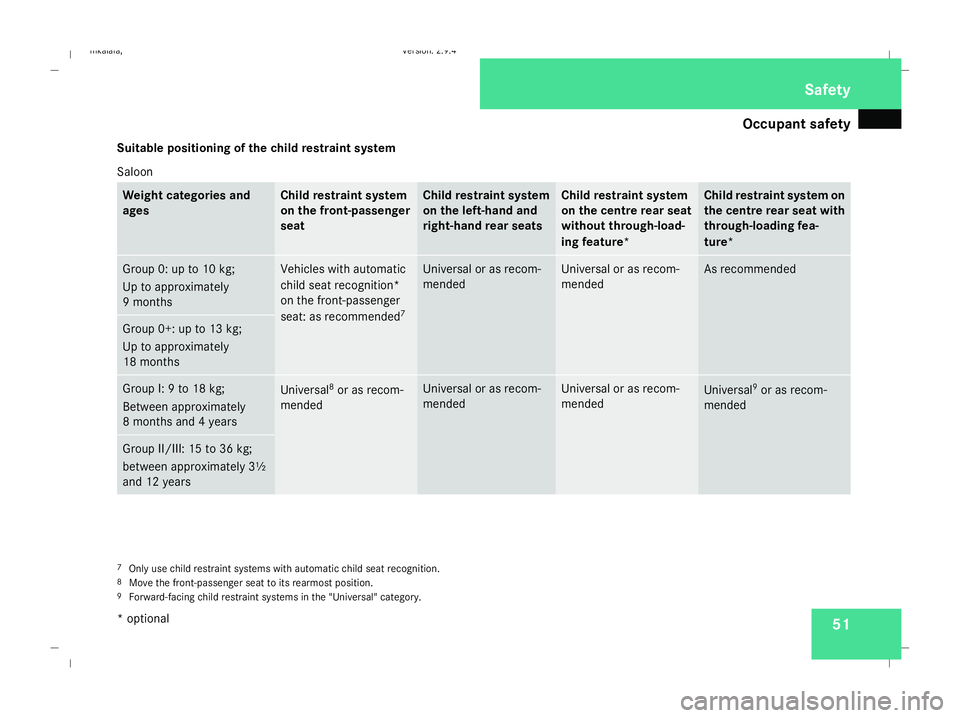
Occupant safety
51
Suitable positioning of the child restraint system
Saloon Weight categories and
ages Child restraint system
on the front-passenger
seat Child restraint system
on the left-hand and
right-hand rear seats Child restraint system
on the centre rear seat
without through-load-
ing feature* Child restraint system on
the centre rear seat with
through-loading fea-
ture*
Group 0: up to 10 kg;
Up to approximately
9 months Vehicles with automatic
child seat recognition*
on the front-passenger
seat: as recommended
7 Universal or as recom-
mended Universal or as recom-
mended As recommended
Group 0+: up to 13 kg;
Up to approximately
18 months Group I: 9 to 18 kg;
Between approximately
8 months and 4 years
Universal
8
or as recom-
mended Universal or as recom-
mended Universal or as recom-
mended
Universal
9
or as recom-
mended Group II/III: 15 to 36 kg;
between approximately 3½
and 12 years
7
Only use child restraint systems with automatic child seat recognition.
8 Move the front-passenger seat to its rearmost position.
9 Forward-facing child restraint systems in the "Universal" category. Safety
* optional
211_AKB; 2; 5, en-GB
mkalafa,
Version: 2.9.4 2008-02-29T16:57:07+01:00 - Seite 51 ZDateiname: 6515_3416_02_buchblock.pdf; preflight
Page 55 of 401
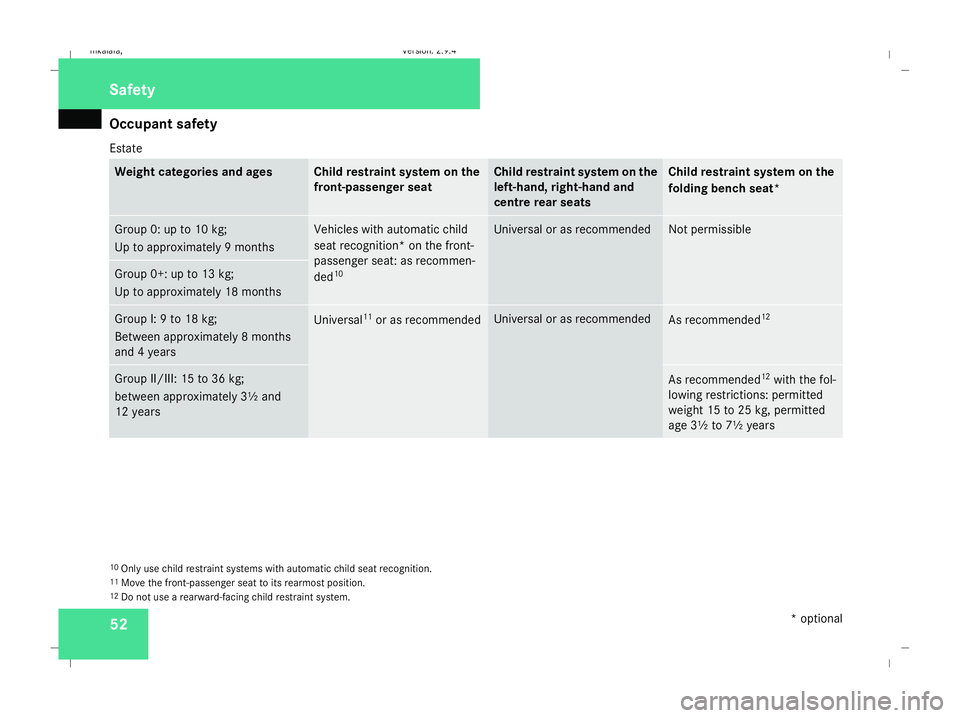
Occupant safety
52
Estate Weight categories and ages Child restraint system on the
front-passenger seat Child restraint system on the
left-hand, right-hand and
centre rear seats Child restraint system on the
folding bench seat*
Group 0: up to 10 kg;
Up to approximately 9 months Vehicles with automatic child
seat recognition* on the front-
passenger seat: as recommen-
ded 10 Universal or as recommended Not permissible
Group 0+: up to 13 kg;
Up to approximately 18 months
Group I: 9 to 18 kg;
Between approximately 8 months
and 4 years Universal
11
or as recommended Universal or as recommended
As recommended
12 Group II/III: 15 to 36 kg;
between approximately 3½ and
12 years As recommended
12
with the fol-
lowing restrictions: permitted
weight 15 to 25 kg, permitted
age 3½ to 7½ years 10
Only use child restraint systems with automatic child seat recognition.
11 Move the front-passenger seat to its rearmost position.
12 Do not use a rearward-facing child restraint system. Safety
* optional
211_AKB; 2; 5, en-GB
mkalafa,
Version: 2.9.4 2008-02-29T16:57:07+01:00 - Seite 52Dateiname: 6515_3416_02_buchblock.pdf; preflight
Page 57 of 401
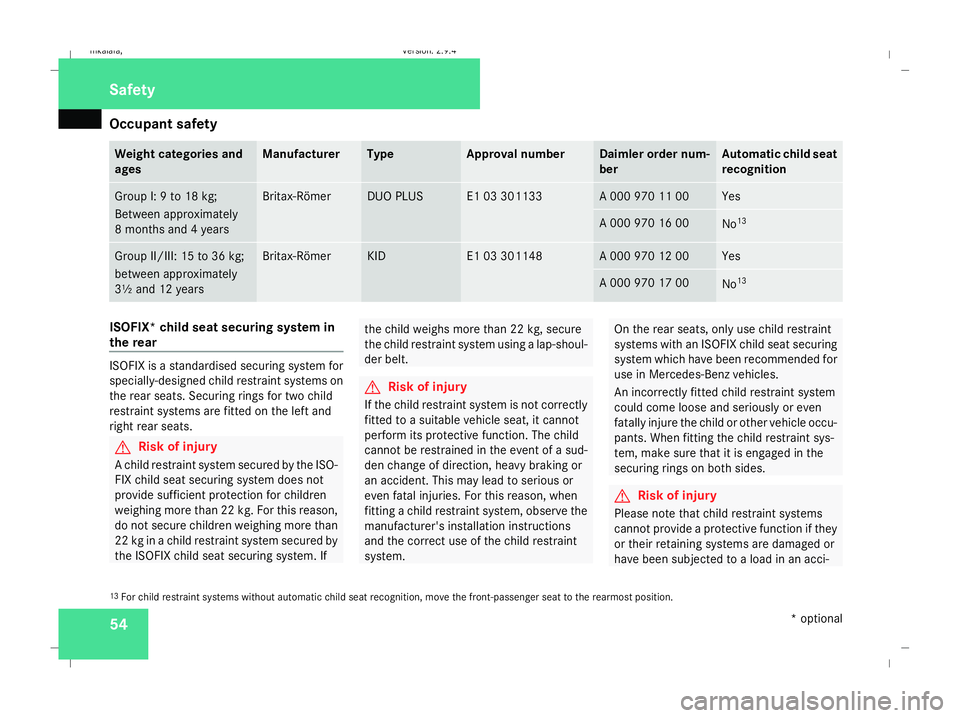
Occupant safety
54 Weight categories and
ages Manufacturer Type Approval number Daimler order num-
ber Automatic child seat
recognition
Group I: 9 to 18 kg;
Between approximately
8 months and 4 years Britax-Römer DUO PLUS E1 03 301133 A 000 970 11 00 Yes
A 000 970 16 00
No
13 Group II/III: 15 to 36 kg;
between approximately
3½ and 12 years Britax-Römer KID E1 03 301148 A 000 970 12 00 Yes
A 000 970 17 00
No
13 ISOFIX* child seat securing system in
the rear
ISOFIX is a standardised securing system for
specially-designed child restraint systems on
the rear seats. Securing rings for two child
restraint systems are fitted on the left and
right rear seats. G
Risk of injury
A child restraint system secured by the ISO-
FIX child seat securing system does not
provide sufficient protection for children
weighing more than 22 kg. For this reason,
do not secure children weighing more than
22 kg in a child restraint system secured by
the ISOFIX child seat securing system. If the child weighs more than 22 kg, secure
the child restraint system using a lap-shoul-
der belt. G
Risk of injury
If the child restraint system is not correctly
fitted to a suitable vehicle seat, it cannot
perform its protective function. The child
cannot be restrained in the event of a sud-
den change of direction, heavy braking or
an accident. This may lead to serious or
even fatal injuries. For this reason, when
fitting a child restraint system, observe the
manufacturer's installation instructions
and the correct use of the child restraint
system. On the rear seats, only use child restraint
systems with an ISOFIX child seat securing
system which have been recommended for
use in Mercedes-Benz vehicles.
An incorrectly fitted child restraint system
could come loose and seriously or even
fatally injure the child or other vehicle occu-
pants. When fitting the child restraint sys-
tem, make sure that it is engaged in the
securing rings on both sides.
G
Risk of injury
Please note that child restraint systems
cannot provide a protective function if they
or their retaining systems are damaged or
have been subjected to a load in an acci-
13 For child restraint systems without automatic child seat recognition, move the front-passenger seat to the rearmost position. Safety
* optional
211_AKB; 2; 5, en-GB
mkalafa,
Version: 2.9.4 2008-02-29T16:57:07+01:00 - Seite 54Dateiname: 6515_3416_02_buchblock.pdf; preflight
Page 58 of 401
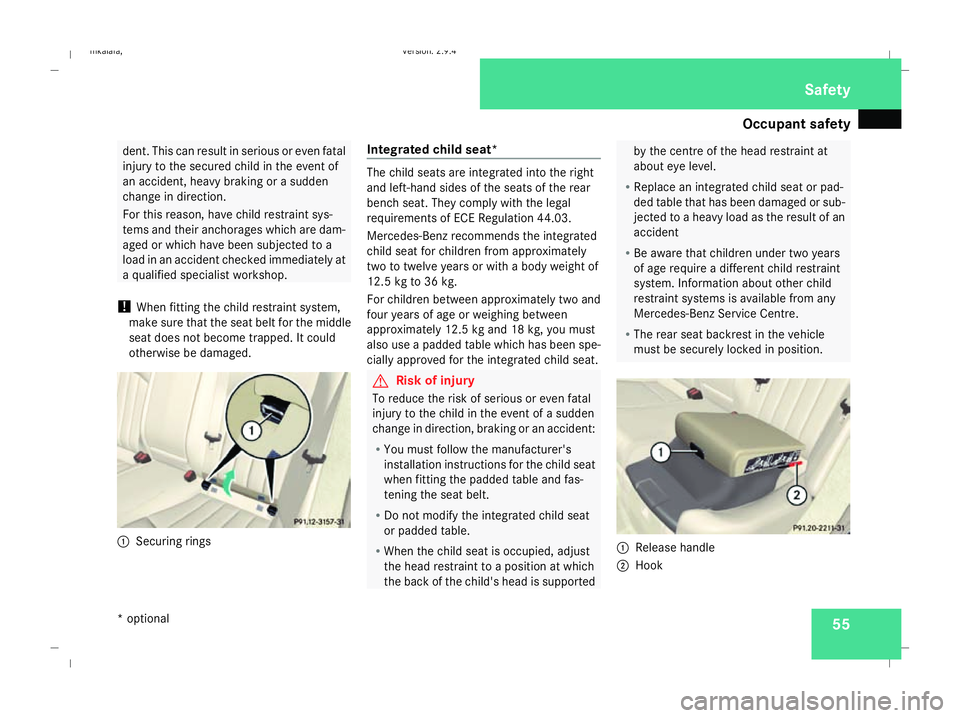
Occupant safety
55dent. This can result in serious or even fatal
injury to the secured child in the event of
an accident, heavy braking or a sudden
change in direction.
For this reason, have child restraint sys-
tems and their anchorages which are dam-
aged or which have been subjected to a
load in an accident checked immediately at
a qualified specialist workshop.
! When fitting the child restraint system,
make sure that the seat belt for the middle
seat does not become trapped. It could
otherwise be damaged. 1
Securing rings Integrated child seat* The child seats are integrated into the right
and left-hand sides of the seats of the rear
bench seat. They comply with the legal
requirements of ECE Regulation 44.03.
Mercedes-Benz recommends the integrated
child seat for children from approximately
two to twelve years or with a body weight of
12.5 kg to 36 kg.
For children between approximately two and
four years of age or weighing between
approximately 12.5 kg and 18 kg, you must
also use a padded table which has been spe-
cially approved for the integrated child seat.
G
Risk of injury
To reduce the risk of serious or even fatal
injury to the child in the event of a sudden
change in direction, braking or an accident:
R You must follow the manufacturer's
installation instructions for the child seat
when fitting the padded table and fas-
tening the seat belt.
R Do not modify the integrated child seat
or padded table.
R When the child seat is occupied, adjust
the head restraint to a position at which
the back of the child's head is supported by the centre of the head restraint at
about eye level.
R Replace an integrated child seat or pad-
ded table that has been damaged or sub-
jected to a heavy load as the result of an
accident
R Be aware that children under two years
of age require a different child restraint
system. Information about other child
restraint systems is available from any
Mercedes-Benz Service Centre.
R The rear seat backrest in the vehicle
must be securely locked in position. 1
Release handle
2 Hook Safety
* optional
211_AKB; 2; 5, en-GB
mkalafa,
Version: 2.9.4 2008-02-29T16:57:07+01:00 - Seite 55 ZDateiname: 6515_3416_02_buchblock.pdf; preflight
Page 68 of 401
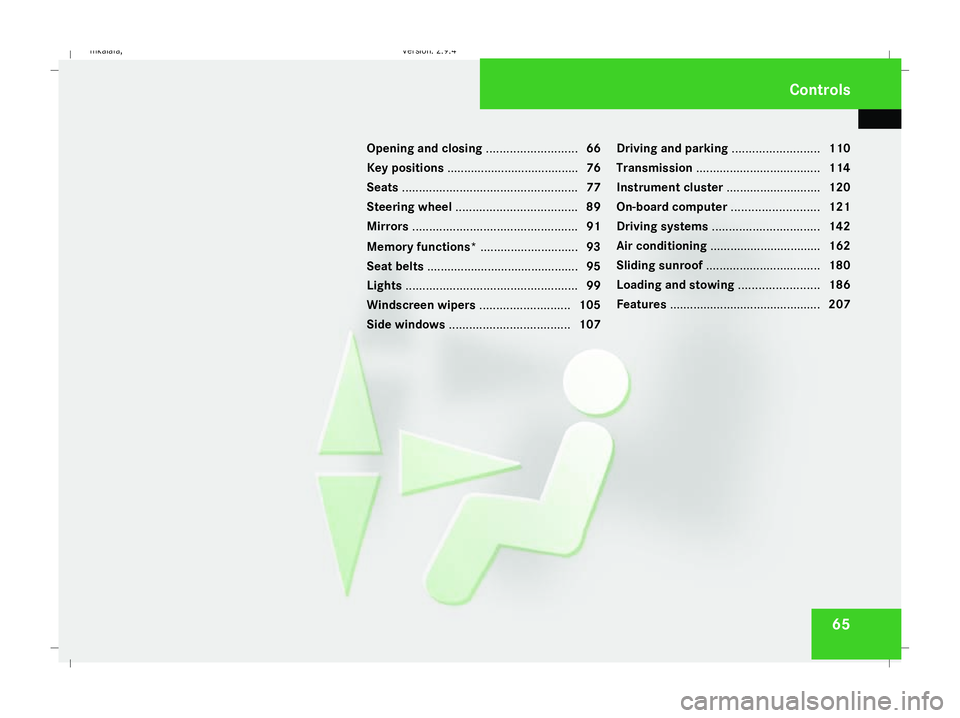
65
Opening and closing
...........................66
Key positions ....................................... 76
Seats .................................................... 77
Steering wheel .................................... 89
Mirrors ................................................. 91
Memory functions* .............................93
Seat belts ............................................. 95
Lights ................................................... 99
Windscreen wipers ...........................105
Side windows .................................... 107Driving and parking
..........................110
Transmission ..................................... 114
Instrument cluster ............................120
On-board computer ..........................121
Driving systems ................................ 142
Air conditioning ................................. 162
Sliding sunroof .................................. 180
Loading and stowing ........................186
Features ............................................. 207 Controls
211_AKB; 2; 5, en-GB
mkalafa,
Version: 2.9.4
2008-02-29T16:57:07+01:00 - Seite 65 Dateiname: 6515_3416_02_buchblock.pdf; preflight